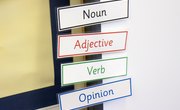Grammar can be a tough subject to teach because it seems the easiest way to get the information across involves passive students, lecturing teachers and worksheets. Students learn best, however, when they are actively engaged in the learning process. Creating grammar lessons that come alive requires creativity, but the smiles on the students faces will be reward enough to keep it up. Liven up a subject-verb agreement lesson by transforming kids into detectives on the hunt for interesting pictures.
Review
Prepare a five- or 10-minute review on subjects and verbs. The subject of a sentence is the person, place, thing, idea or activity that the sentence is about, and the verb tells what the subject does. Display one or two sentences on the board and ask students to read the sentence and then come to the board to circle the subject and the verb. Ask for volunteers to compose a sentence; then ask the other students to identify the subject and verb.
New Information
Point out that the subject and the verb have to agree, meaning if the subject is singular, the verb must also be singular, and the same is true for plurals. Make two columns on the board, headed subject and verb. Ask students to name several singular subjects and verbs and record them on the board. Pick a random subject and a random verb and then compose a sentence. For example say, "The dog barks at the mailman. If I want to change the subject to plural, I have to add an 's,' but when I change the verb to plural I take away the 's': The dogs bark at the mailman." Continue with several more examples by picking words from each column. Ask students to provide example sentences as well.
Activity
Distribute old magazines, newspapers, scissors and glue. Ask students to find and cut out three pictures of a subject and three pictures of a verb. They may be singular or plural, but they must agree. Ask students to create rebus sentences, using pictures for the subject and the verb and supplying the words for the rest. Show several prepared examples. You might find a picture of a group of girls and a picture of someone surfing. The sentence would say, "The girls surf after school." Older students might create stories instead of sentences. Encourage students to be creative or silly as long as the subjects and verbs are in agreement. Conclude the lesson by asking students to share their rebus sentences or stories.
Extension
Extend the lesson at another time by having students find sentences in newspapers and magazines and draw their own illustrations of the subjects and verbs. Students might also find sentences and then highlight the subjects and verbs to determine if they are in agreement.
Related Articles
References
Writer Bio
Dana Tuffelmire has been writing for DMS for three years. She taught elementary school for seven years and earned a master’s of education degree with a specialization in literacy. She is currently a stay-at-home mom to two sons. Her dream is to one day write a children's book.











